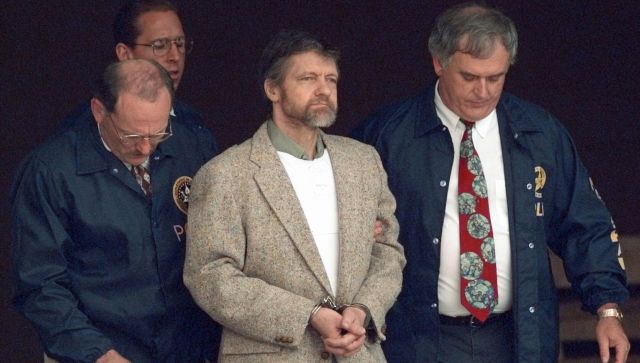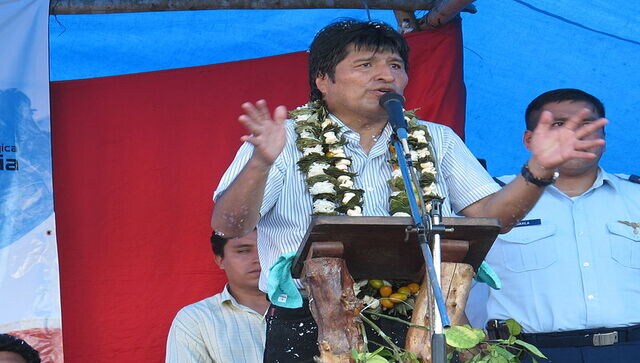Who was the ‘Unabomber’ Ted Kaczynski, ‘twisted’ Harvard genius who terrorised US for 17 years?
Theodore ‘Ted’ Kaczynski, one of the most dreaded domestic terrorists in the US, reportedly died by suicide in a US prison on Saturday. From 1978 to 1995, he made homemade bombs and sent them to universities, planted them on airlines, targeting academics, scientists and business executives

Theodore 'Ted' Kaczynski is flanked by federal agents as he is led to a car from the federal courthouse in Helena, Montana, in April 1996. Kaczynski, known as the “Unabomber,” who carried out a 17-year bombing campaign that killed three people and injured 23 others, died by suicide, four people familiar with the matter told The Associated Press on Sunday. File photo/AP
He unleashed terror in the United States for 17 years from a dingy shack in rural Montana. His bombing campaign killed three people and left 23 injured. The Federal Bureau of Investigation (FBI) spent years chasing him and he earned the moniker of the “Unabomber”. Now Theodore “Ted” Kaczynski, one of the most dreaded domestic terrorists in the US, is dead. He was 81 and reportedly died by suicide.
Kaczynski, who was 81 and suffering from late-stage cancer, was found unresponsive in his cell at the Federal Medical Center in Butner, North Carolina, around 12:30 am on Saturday. Emergency responders performed CPR and revived him before he was transported to a hospital, where he was pronounced dead later Saturday morning, reports The Associated Press.
Before being transferred to the prison medical facility, Kaczynski was held in the supermax prison in Colorado’s Florence since May 1998 after he was sentenced to four life sentences and 30 years for a dreadful terror campaign that the US on edge. He confessed to committing 16 bombings from 1978 to 1995, which left several victims maimed.
Related Articles
We take a look at the life of Kaczynski, his reign of terror and how he was arrested.
Who was Ted Kaczynski?
Born in Chicago on 22 May 1942, he was one of two children of working-class Polish-American parents. He was a loner but very bright and graduated from school at 15. He won a scholarship to Harvard University, where he studied mathematics.
After he graduated in 1962, he went on to earn a master’s and doctorate degree in mathematics from the University of Michigan. At 25, he became the youngest assistant professor in the history of the University of California, Berkley, where he taught undergraduate geometry and calculus for two years before he resigned in 1969 without providing a reason.
Kaczynski moved back with his parents in Chicago and lived with them until 1971 before he moved to the woods near Lincoln, Montana. He built himself a tar-paper cabin, which served as the base of his bombing campaign.

How did Kaczynski become the Unabomber?
“He wasn’t exactly gregarious, but he was extremely articulate,” Dale Eickelman, Kaczynski’s friend in his early high school years, told the Daily Southtown newspaper in Chicago after Kaczynski’s arrest.
“I remember Ted was very good at chemistry… I remember Ted had the know-how of putting together things like batteries, wire leads, potassium nitrate and whatever, and creating explosions” at the age of 12 and 13, Eickelman added.
He channelled all that talent to become a terrorist.
Kaczynski made homemade bombs and started targeting people in 1978. He sent some of them via mail using the US postal service and he hand-delivered some.
The bomber’s first victim was Buckley Crist, a professor of engineering at Northwestern University. He found a package in the parking lot of his office building and realised something was amiss when he saw that it listed the return address as his. The professor altered campus security and the bomb exploded when a security guard opened the package, leaving him with a hand injury.
In the next seven years, Kaczynski sent nine handmade pipe bombs to people including workers at United Airlines and American Airlines and various academic administrators, according to History.com. In 1979, he placed a bomb in the cargo hold of an American Airlines plane that gave off smoke during a domestic flight, forcing an emergency landing at Dulles International Airport near Washington.
This caught the attention of the FBI and the agents would spend years trying to nab a perpetrator who left no solid clues and made no demands. They dubbed the case UNABOM, for University and Airline Bombings and Kaczynski became infamous as the Unabomber.

In December 1985, he sent a bomb to Hugh Scrutton, a computer store owner in Sacramento, California and that was the first causality of his attacks. Then for six years, between 1987 and 1993, Kaczynski stopped the attacks and no bombs were sent, further confusing investigators.
But when resumed the terror activity, his bombs became more sophisticated. He killed a New Jersey advertising executive Thomas Mosser, who had worked on improving the public image of oil major Exxon, with a mail bomb in 1994 and similarly, murdered, Gilbert Brent Murray, head of a California timber industry lobbying group, with a mail bomb the next year.
In all, the Unabomber set off 17 bombs, injuring around 25 people, some of whom lost vision, hearing or fingers, reports Reuters.
But why did Kaczynski go rogue?
It is not exactly known why a math genius started making bombs and attacking people. Some say it could be his participation in an infamous Harvard experiment.
At the university, he was subject to an experiment by Harvard psychologist Henry A Murray that was backed by the Central Intelligence Agency (CIA). The study was reportedly part of the CIA programme named Project MK-Ultra inspired by the use of mind-control techniques on US prisoners of war in Korea by the Soviet Union, China and North Korea, according to a report in The Washington Post.
A document made public by the CIA in 2018 revealed that the programme sought to understand how to control minds by using drugs like LSD at times. However, there was no evidence that these were used on Kaczynski.
The experiment, which also involved mock investigations in which participants’ beliefs were belittled, is said to have affected Kaczynski.
According to a report in Reuters, psychologists subjected volunteer students, including Kaczynski, to hours of extreme verbal and emotional abuse as part of an attempt to measure how people handled stress. The experiment, now regarded as unethical, lasted three years.
Others have cited a period in Kaczynski’s childhood when he spent long periods in isolation due to a severe outbreak of hives. When he lived in the cabin in Lincoln, the destruction of surrounding forests for development left him upset.

How was the Unabomber arrested?
The FBI began an investigation into the UNABOMB case in 1979.
More than 150 investigators spent years tracing the lives of the victims, recovering bomb components and searching for other forensic clues, reports The New York Times (NYT). They were confident that the suspect was raised in Chicago and lived in the Salt Lake City and San Fransisco areas but could not figure out who was it. They were not even sure of their gender.
In 1995, he sent letters to The New York Times and The Washington Post demanding that they publish a 3,500-word essay written by him on the perils of industrialisation.
“The Industrial Revolution and its consequences have been a disaster for the human race,” the essay began. Kaczynski detailed how modernisation has destabilized society, subjected humans to indignities and “inflicted severe damage on the natural world”.
This essay was published by the newspapers later in 1995 after consulting with the FBI. The investigators hoped that readers could help identify the author.
The move paid off when the bomber’s younger brother David, recognised phrases and topics in the essay and told police he believed it was written by Ted. And finally, the Unabomber was arrested in 1996 from the shack in Montana. They also recovered 40,000 handwritten journal pages with information on bomb-making experiments and descriptions of his crimes and a ‘live’ bomb.
In January 1998, Kaczynski pleaded guilty in Sacramento, California, as part of a deal that ensured he would not get the death sentence. Later that year, he was sentenced to four life sentences plus 30 years in prison, according to the NYT.
With inputs from agencies
Read all the Latest News, Trending News, Cricket News, Bollywood News,
India News and Entertainment News here. Follow us on Facebook, Twitter and Instagram.
also read

Obama nominates Merrick Garland, not Sri Srinivasan, to Supreme Court
President Barack Obama called Merrick Garland one of the country's "sharpest legal minds".

On this day: A look at historic events that took place on 22 January
On 20 January 2006, Evo Morales, a part of the Aymara group, took oath as the president of Bolivia, winning 54 percent of the vote and becoming the country’s first indigenous president

Manhunt: Unabomber review — Netflix's true crime series is low key but high on impact
Mindhunter may be the more engrossing show, but it lacks the one thing Manhunt: Unabomber wears like a badge of honour – heart


